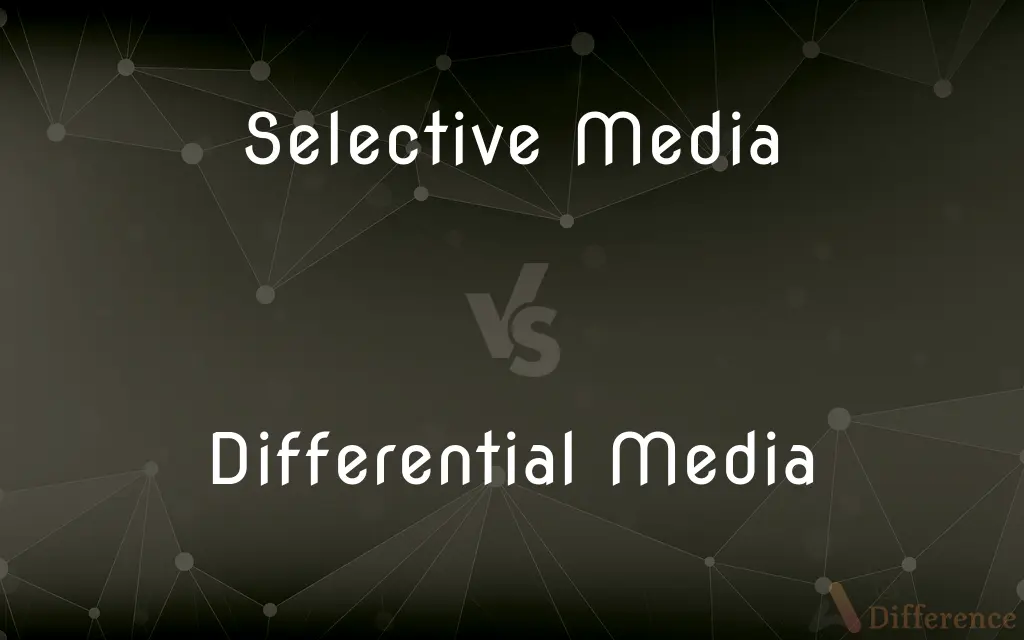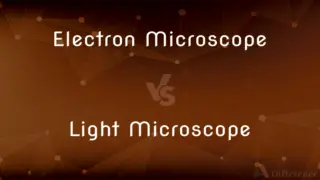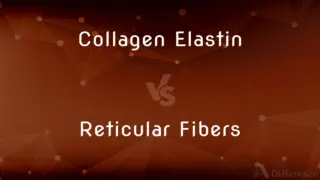Selective Media vs. Differential Media — What's the Difference?
Edited by Tayyaba Rehman — By Fiza Rafique — Published on December 28, 2023
Selective Media inhibits growth of certain organisms while allowing others to grow. Differential Media distinguishes organisms based on their metabolic differences.

Difference Between Selective Media and Differential Media
Table of Contents
ADVERTISEMENT
Key Differences
Selective Media is designed to promote the growth of specific microorganisms while inhibiting the growth of undesired ones. In contrast, Differential Media does not inhibit any growth but contains indicators that help differentiate between types of microorganisms based on their metabolic activities.
The primary purpose of Selective Media is to provide an environment where only specific types of microorganisms can thrive. On the other hand, Differential Media aims to provide a general environment where multiple types of microorganisms can grow, but their growth would lead to different visual characteristics depending on their metabolic properties.
An example of Selective Media is Sabouraud's agar, which is used to promote fungal growth while suppressing bacterial growth. Differential Media examples include MacConkey agar, where lactose fermenters turn the media pink or red, distinguishing them from non-fermenters.
Another differentiation point is that Selective Media may contain specific antibiotics or chemicals to suppress certain bacterial growth. Differential Media, however, might contain pH indicators or other compounds that change in response to specific microbial actions, providing a visual difference.
It's important to understand that while Selective Media discriminates based on growth, Differential Media discriminates based on appearance. Both types of media are crucial tools in microbiology for the isolation, identification, and study of microorganisms.
ADVERTISEMENT
Comparison Chart
Purpose
Promotes growth of specific organisms
Differentiates between organisms based on metabolic activities
Key Components
Antibiotics or specific chemicals
PH indicators or metabolic substrates
Example
Sabouraud's agar
MacConkey agar
Growth Inhibition
Inhibits growth of certain organisms
Does not inhibit growth of any specific organism
Visual Differentiation
Based on presence or absence of growth
Based on color or appearance changes
Compare with Definitions
Selective Media
A growth medium formulated to allow certain organisms to grow while suppressing others.
Using Selective Media, scientists can isolate specific bacterial strains from mixed samples.
Differential Media
Media that differentiates microbes based on their reactions on the media.
The fermentation of sugars in some Differential Media results in a pH change, indicating specific bacterial activities.
Selective Media
Culture media with specific additives to block or limit certain bacterial growth.
Eosin methylene blue (EMB) agar is a Selective Media that inhibits the growth of Gram-positive bacteria.
Differential Media
Media that allows differentiation of bacterial colonies based on their metabolic activities.
Differential Media like MacConkey agar can visually distinguish between lactose fermenters and non-fermenters.
Selective Media
Media tailored to isolate or enrich the growth of specific bacterial species.
Bile salts in certain Selective Media prevent the growth of Gram-positive bacteria.
Differential Media
A growth medium enabling the visual distinction between microbial species due to varying metabolic reactions.
When using Differential Media, colonies might display color changes based on their metabolic properties.
Selective Media
A nutritive matrix designed for the preferential growth of a specific microorganism.
Selective Media enriched with specific nutrients can help in studying particular metabolic pathways.
Differential Media
A nutritive matrix highlighting differences in microbial behavior or characteristics.
Differential Media can aid in the identification of bacterial strains by showcasing different colony morphologies.
Selective Media
Media that favors the growth of particular microbes and inhibits others.
Mannitol salt agar is a Selective Media used primarily for the isolation of staphylococci.
Differential Media
Culture media incorporated with indicators revealing differences between organisms.
Blood agar is a Differential Media showing hemolytic activities of bacterial colonies.
Common Curiosities
Can a medium be both Selective and Differential?
Yes, some media, like MacConkey agar, combine both characteristics.
Why use Selective Media over regular media?
Selective Media is useful when isolating specific organisms from mixed samples.
Can Differential Media inhibit growth?
No, Differential Media differentiates microbes based on metabolic reactions but doesn't inhibit growth.
How does Differential Media display different microbial growth?
Differential Media often uses indicators that change color or appearance based on microbial metabolic activities.
Are Selective Media and Differential Media used in medical microbiology?
Yes, both are extensively used in medical labs to isolate and identify pathogenic microbes.
Can Differential Media help in antibiotic resistance testing?
While it can indicate different growth patterns, specific antibiotic resistance tests are more suitable for this purpose.
What might be added to Selective Media to inhibit bacterial growth?
Antibiotics, bile salts, or specific chemicals can be added to Selective Media.
Are there risks in using Selective Media?
Incorrect formulation or contamination might yield inaccurate results.
Do Selective Media always suppress bacterial growth?
Selective Media suppresses certain bacterial types, allowing specific organisms to grow.
What's a key component in Selective Media for fungal growth?
Sabouraud's agar, which promotes fungal growth, often contains antibiotics to inhibit bacterial growth.
Is MacConkey agar Selective or Differential?
MacConkey agar acts as both – it's selective against Gram-positives and differential for lactose fermentation.
Can fungi be isolated using Selective Media?
Yes, there are Selective Media formulations designed to promote fungal growth.
How do you choose between Selective Media and Differential Media?
The choice depends on the purpose – isolation of a specific organism requires Selective Media, while differentiation needs Differential Media.
Why is color an essential factor in Differential Media?
Color changes, often due to pH indicators, visually differentiate microbial species based on their metabolic reactions.
Is blood agar a type of Differential Media?
Yes, blood agar is Differential Media used to distinguish hemolytic activities of bacteria.
Share Your Discovery

Previous Comparison
Long Vowels vs. Short Vowels
Next Comparison
FIR vs. ChargesheetAuthor Spotlight
Written by
Fiza RafiqueFiza Rafique is a skilled content writer at AskDifference.com, where she meticulously refines and enhances written pieces. Drawing from her vast editorial expertise, Fiza ensures clarity, accuracy, and precision in every article. Passionate about language, she continually seeks to elevate the quality of content for readers worldwide.
Edited by
Tayyaba RehmanTayyaba Rehman is a distinguished writer, currently serving as a primary contributor to askdifference.com. As a researcher in semantics and etymology, Tayyaba's passion for the complexity of languages and their distinctions has found a perfect home on the platform. Tayyaba delves into the intricacies of language, distinguishing between commonly confused words and phrases, thereby providing clarity for readers worldwide.














































